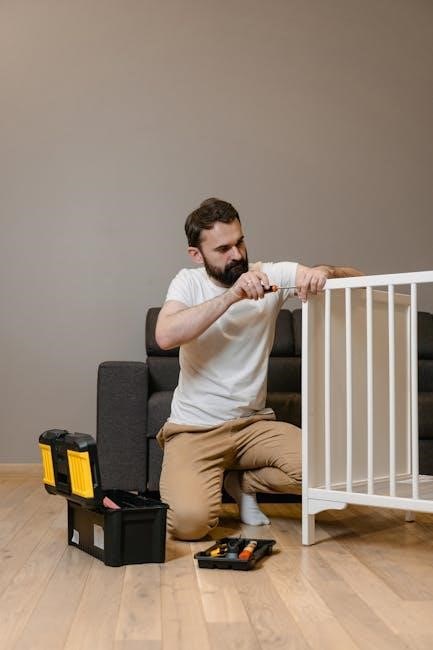Online crib manuals offer convenient access to assembly instructions, safety guidelines, and maintenance tips. They ensure proper setup, reducing risks and promoting a safe environment for infants.
1.1 Overview of Crib Instruction Manuals
Crib instruction manuals provide comprehensive guidance for assembling, using, and maintaining cribs safely. They typically include step-by-step instructions, safety warnings, and detailed diagrams. These manuals often cover mattress size requirements, assembly tools, and essential precautions to ensure a secure environment for infants. Many manuals also address common issues like missing parts or alignment problems, offering troubleshooting tips. Additionally, they may include information on converting cribs to toddler beds and long-term maintenance. By following these manuals, parents can ensure their crib meets safety standards and remains functional over time. Online access to these manuals makes it easier for users to reference instructions whenever needed, promoting convenience and peace of mind. Proper adherence to these guidelines is crucial for the child’s safety and well-being.
1.2 Importance of Following Crib Assembly Instructions
Following crib assembly instructions is crucial for ensuring the safety and structural integrity of the crib. Proper assembly prevents hazards such as loose joints, unstable parts, or missing components, which could lead to accidents. Instructions provide clear guidelines to avoid common mistakes and ensure the crib meets safety standards. Ignoring these steps can result in a poorly constructed crib, posing serious risks to the child. Manufacturers design these instructions to prevent potential dangers, so adhering to them is essential. Additionally, failure to follow instructions may void warranties or lead to legal and ethical concerns. Always prioritize careful assembly to create a secure and safe environment for your child.

Benefits of Using Online Crib Manuals
Online crib manuals offer instant access, reduce paper waste, and provide updated safety guidelines. They ensure proper assembly, enhance convenience, and promote eco-friendly alternatives to traditional paper manuals.
2.1 Convenience of Accessing Manuals Online
Accessing crib instruction manuals online offers unparalleled convenience, allowing users to retrieve information instantly from any device with internet connectivity. This eliminates the need to store physical copies, reducing clutter and the risk of losing the manual. Online manuals are searchable, making it easier to find specific instructions quickly. Additionally, hyperlinks and interactive content can enhance understanding. Parents can access manuals at any time, even during late-night assembly, without needing to sift through paperwork. This convenience reduces stress and saves time, ensuring a smoother assembly process. Furthermore, online manuals are often updated, providing the most current safety guidelines and assembly tips, which is crucial for ensuring a secure crib setup.
2.2 Environmentally Friendly Alternative to Paper Manuals
Online crib instruction manuals provide an eco-friendly alternative to traditional paper manuals, reducing the demand for printed materials. By eliminating the need for paper, ink, and physical distribution, online manuals help conserve natural resources and lower carbon emissions. This shift supports sustainability efforts by minimizing deforestation and reducing waste. Digital manuals also reduce the environmental impact of transporting physical copies, as they can be accessed instantly worldwide. Additionally, online content can be easily updated without the need for reprinting, further reducing paper waste. This makes online crib manuals a more responsible and environmentally conscious choice for parents and manufacturers alike, promoting a greener future while maintaining accessibility and convenience.
2.3 Regular Updates and Revisions
One of the significant advantages of online crib instruction manuals is the ability to receive regular updates and revisions. Manufacturers often improve their products based on feedback, safety standards, and technological advancements. Online manuals can be updated in real-time, ensuring users always have access to the most accurate and up-to-date information. This eliminates the risk of using outdated instructions, which could lead to safety hazards or assembly errors. Revised manuals often include new safety guidelines, corrected diagrams, or additional features. Parents can trust that the information they rely on for crib assembly is current and reliable, providing peace of mind and ensuring the safest environment for their child.

Safety Guidelines in Crib Manuals
Crib manuals provide essential safety guidelines to ensure a secure environment for infants. They outline material safety, proper assembly, and regular inspections to prevent hazards and injuries.
3.1 General Safety Instructions for Crib Assembly
Always adhere to the manufacturer’s instructions to ensure a safe crib assembly. Begin by inspecting all parts for damage or wear. Tighten bolts and screws firmly to avoid loose joints. Place the crib on a stable, flat surface to prevent tipping. Avoid using damaged or altered parts, as they may compromise safety. Never modify the crib’s design, as this could void safety certifications. Keep soft bedding, toys, or loose items away to reduce suffocation risks. Ensure the mattress fits snugly and is firm. Regularly inspect the crib for stability and tighten any loose parts. Supervise children during assembly to prevent accidents. Follow these guidelines to create a secure environment for your baby.
- Inspect parts for damage before assembly.
- Ensure proper tightening of all bolts and screws.
- Place the crib on a stable, flat surface.
- Avoid modifications or damaged parts.
- Use a snug, firm mattress.
- Regularly inspect the crib for stability.
3.2 Warning Signs of an Unsafe Crib
Identifying warning signs of an unsafe crib is crucial for ensuring your baby’s safety. Look for loose or unstable parts, as they can lead to structural failure. Gaps between the mattress and crib sides or uneven surfaces are red flags. Broken slats, missing hardware, or worn-out joints indicate potential hazards. Additionally, peeling paint, scratches, or signs of damage on the frame may signal unsafe conditions. If the crib wobbles or has an uneven base, it poses a tipping risk. Always address these issues promptly to maintain a secure environment for your child.
- Loose or unstable parts can lead to structural failure.
- Gaps between the mattress and crib sides pose entrapment risks.
- Broken slats or missing hardware compromise safety.
- Uneven surfaces or wobbling increase tipping hazards.
- Signs of wear and tear, like peeling paint, may indicate poor quality.
3.3 Safety Checks Post-Assembly
After assembling the crib, perform a thorough safety inspection to ensure everything is secure. Check for any loose joints or bolts and tighten them if necessary. Verify that the mattress fits snugly, with no gaps between the mattress and the crib sides. Ensure all slats are evenly spaced and sturdy. Look for any sharp edges or protruding hardware that could harm your baby. Test the crib’s stability by gently rocking it to ensure it doesn’t wobble or tip. Finally, double-check that all safety features, such as fixed sides, are properly engaged. A safe crib ensures your baby’s well-being.
- Tighten all joints and bolts for stability.
- Ensure the mattress fits perfectly with no gaps.
- Verify slats are secure and evenly spaced.
- Check for sharp edges or protruding parts.
- Test the crib’s stability by gently rocking it.

Finding and Using Crib Manuals Online
Accessing crib manuals online is straightforward. Visit the manufacturer’s official website, search for your crib model, and download the PDF manual. Use specific search terms like “brand name crib manual” for quick results. Always verify the manual’s authenticity by checking for official logos or contacting customer support. Ensure the manual is updated to the latest version for accurate assembly instructions. This convenient access helps you assemble the crib safely and efficiently, avoiding costly mistakes.
- Visit official manufacturer websites for authentic manuals.
- Use specific search terms to find your crib model.
- Verify manual authenticity through official logos or support.
4.1 How to Locate Crib Manuals on Manufacturer Websites
To find crib manuals on manufacturer websites, start by visiting the official site of your crib’s brand. Look for a “Support” or “Customer Service” section, which typically houses downloadable manuals. Use the search bar with specific terms like “brand name crib manual” to quickly locate your model. If unsure, check for the model number on the crib or packaging. Ensure the manual is authentic by verifying official logos or contacting support. Regularly updated manuals are crucial for safety and accuracy. Download and save the manual for easy access during assembly.
- Visit the manufacturer’s official website.
- Navigate to the Support or Customer Service section.
- Use specific search terms like “brand name crib manual.”
- Verify authenticity through official logos or customer support.
4.2 Verifying the Authenticity of Online Manuals
Verifying the authenticity of online crib manuals is crucial to ensure safety and accuracy. Always download manuals from the official manufacturer’s website. Look for official logos, watermarks, or copyright information to confirm legitimacy. Cross-reference the manual with any physical copies provided with your crib. Check for specific details like model numbers and publication dates. Avoid third-party websites, as they may host outdated or incorrect versions. If unsure, contact the manufacturer’s customer support for verification. Genuine manuals will align with the product’s specifications and safety standards. Ensuring authenticity prevents assembly errors and potential safety risks.
- Download from official manufacturer websites.
- Check for logos, watermarks, and copyright information.
- Compare with physical copies or model numbers.
- Contact customer support for verification if unsure.
4.3 Navigating the Content of Crib Manuals
Navigating crib manuals online is straightforward once you understand their structure. Most manuals begin with an index or table of contents, allowing quick access to specific sections. Detailed step-by-step instructions are typically accompanied by diagrams or photos to clarify assembly steps. Safety guidelines are often highlighted in bold or separate sections for emphasis. Troubleshooting sections address common issues, while maintenance tips ensure long-term use. Manuals may also include FAQs or conversion guides for transitioning to toddler beds. Use digital tools like bookmarks or search functions to find information quickly. Always read the manual thoroughly before starting assembly to ensure a smooth process.
- Use the table of contents for quick navigation.
- Refer to diagrams for visual guidance.
- Highlight safety information for quick reference.
- Utilize digital tools for easier access.

Assembly Preparation
Ensure all components and tools are ready before starting. Clear a flat, stable workspace and organize parts by category. Double-check the list of required tools and materials.
Key steps:
- Gather all parts and tools.
- Prepare a spacious workspace.
- Verify component quantities.
5.1 Tools and Materials Required for Assembly
Assembling a crib typically requires specific tools and materials. Essential tools include a screwdriver (both Phillips and flathead), an Allen wrench, and a socket wrench for bolts. Some cribs may also need a rubber mallet for gently tapping parts into place. Ensure all hardware, such as screws, bolts, and dowels, is included in the packaging. Check the manual for a comprehensive list of required tools to avoid delays. Additionally, having a measuring tape on hand can help verify proper alignment. Always verify the authenticity of the manual to ensure accuracy. Organizing parts and tools beforehand saves time and reduces frustration during assembly. Lastly, double-check that no tools are missing before starting the process.
5.2 Preparing the Workspace for Crib Assembly
Preparing a suitable workspace is crucial for efficient and stress-free crib assembly. Choose a clean, flat, and spacious area, such as a large table or floor, to spread out parts and tools. Cover the surface with a soft cloth or mat to protect the crib components from scratches. Ensure good lighting to clearly see small parts and instructions. Clear the area of distractions, such as toys or clutter, to maintain focus. If assembling on the floor, consider using a rug to prevent slippage. Always check the manual for specific workspace recommendations, as some cribs may require vertical assembly. Organizing parts and tools beforehand saves time and reduces the risk of losing items. A well-prepared workspace ensures a smooth assembly process.
5.3 Step-by-Step Assembly Guidance
Online crib manuals provide detailed, step-by-step assembly guidance to ensure a smooth process. Typically, the manual begins with unboxing and inventorying all parts and hardware. Each stage, from attaching the legs to installing the mattress support, is outlined with clear instructions. Visual aids like diagrams or images often accompany text to clarify complex steps. Users are advised to follow the sequence carefully, as deviations may lead to structural instability. Tips for aligning parts correctly and tightening bolts properly are usually emphasized. The manual may also highlight common mistakes to avoid, ensuring safety and durability. Many manuals include trouble-shooting sections for issues like uneven surfaces or loose joints. By adhering to the step-by-step guide, parents can assemble the crib confidently and efficiently, ensuring their child’s safety.

Troubleshooting Common Issues
Online crib manuals address common assembly issues, such as alignment problems, missing parts, and tight joints, offering practical solutions to ensure safety and stability.
6.1 Addressing Alignment Problems During Assembly
Alignment issues during crib assembly can compromise safety and stability. Online manuals often provide detailed diagrams and step-by-step guidance to correct misalignment; Common problems include uneven legs or sides that don’t fit properly. Check for loose joints or parts installed incorrectly. Use a carpenter’s square to ensure all corners are flush. If sides don’t align, verify that hardware is securely tightened and bolts are properly seated. Some manuals suggest using shims for minor adjustments. If issues persist, disassemble and restart the section. Patience is key, as proper alignment ensures the crib’s structural integrity and your baby’s safety. Always refer back to the manual for specific solutions tailored to your crib model.
6.2 Dealing with Missing or Damaged Parts
If parts are missing or damaged during crib assembly, it’s essential to address the issue promptly. Start by double-checking the packaging and inventory list provided in the manual to confirm the absence or damage. If a part is missing, contact the manufacturer’s customer support using the information in the online manual. Provide details like the model number and the specific part needed for a quick resolution. For damaged parts, assess if they can be used safely or if replacements are necessary. Avoid substituting parts, as this could compromise the crib’s safety. Most online manuals include troubleshooting sections or direct links to order replacement parts. Always wait for the correct components before proceeding with assembly to ensure your baby’s safety.
6.3 Resolving Tightness Issues in Joints and Bolts
Tightness issues in joints and bolts are common during crib assembly. If a joint feels too tight, ensure all parts are properly aligned according to the manual. Forcing parts together can damage the crib. If bolts are too tight, they may strip the wood or plastic. Use the tools recommended in the manual to avoid over-tightening. Apply a small amount of silicone-based lubricant to bolts if they stick. If joints are still problematic, check for any debris or uneven surfaces. Sand lightly if necessary. Never overtighten, as this can compromise the crib’s stability. Consult the online manual for specific torque recommendations or contact customer support for guidance.

Maintenance and Upkeep
Regular crib maintenance ensures safety and longevity. Follow online manuals for cleaning, storage, and inspection tips to keep your crib safe and durable, properly maintained over time.
7.1 Cleaning Instructions for Cribs
Proper cleaning is essential for maintaining a crib’s safety and hygiene. Online manuals provide detailed cleaning instructions, such as using mild detergents and avoiding harsh chemicals. Always spot test fabrics first to prevent damage. Hard surfaces can be wiped with a damp cloth, while mattress covers should be washed regularly. Avoid soaking wooden parts to prevent warping. Drying thoroughly is crucial to prevent mold or mildew. Cleaning frequency depends on use, but a deep clean every few months is recommended. Refer to your crib’s manual for specific care instructions, as materials may vary. Regular cleaning ensures a safe and healthy environment for your baby.
7.2 Storage Tips for Disassembled Cribs
Proper storage of disassembled crib parts ensures safety and longevity. Online manuals often provide guidelines for organizing components. Use sturdy boxes or bags to store small hardware, labeling each container for easy identification. Clean all parts before storage to prevent dirt buildup. Avoid stacking heavy items on top of crib components. Store in a dry, cool place to prevent moisture damage or pest infestation. Consider using protective covers for larger pieces to shield them from dust. Keep the assembly manual in an accessible location for future reference. Avoid bending or warping parts during storage, and ensure all joints and bolts are secure. Regularly inspect stored items for signs of damage or wear.
7.3 Regular Inspection of Crib Components
Regular inspection of crib components is crucial for ensuring safety and durability. Online manuals typically recommend inspecting the crib every 3-6 months. Check for cracks, splits, or warping in wooden parts, and ensure all joints and bolts are tight. Examine hardware for signs of wear or rust and verify that mattress support is stable. Look for loose slats or gaps that could pose a hazard. Adhere to the manufacturer’s guidelines for maintenance and repairs. If damage is detected, contact the manufacturer or replace the affected parts immediately. Keeping the crib in optimal condition helps prevent accidents and extends its lifespan. Always refer to the manual for specific inspection procedures tailored to your crib model.

Converting Cribs to Toddler Beds
Online crib manuals guide the transition to toddler beds using conversion kits, ensuring safety and functionality with detailed instructions for a smooth milestone.
8.1 When to Transition to a Toddler Bed
Online crib manuals often provide guidance on transitioning to a toddler bed, typically recommended between 18 months to 3 years. The transition timing depends on the child’s physical and emotional readiness. Signs include climbing out of the crib, showing interest in a “big kid” bed, or needing more space. Safety is a priority, so ensure the crib meets current standards before conversion. Manuals suggest assessing the child’s ability to understand instructions and handle the freedom of a toddler bed. Planning the transition gradually and using the manual’s checklist can help parents decide the right time for a smooth and safe switch.
8.2 Conversion Process and Instructions
Online crib manuals detail the conversion process to a toddler bed, often requiring specific tools like Allen wrenches or bolts. Parents should start by removing the crib side panel and adjusting the mattress height to its lowest setting. Manuals typically outline step-by-step instructions for attaching guardrails and securing the bed frame. Safety is emphasized, with reminders to tighten all bolts and ensure stability. Some manuals include diagrams or videos for clarity. Parents are advised to double-check the setup before allowing the child to use the bed. These instructions ensure a smooth transition while maintaining safety standards, making the process manageable for most caregivers.
8.3 Safety Considerations for Toddler Beds

Safety is paramount when converting a crib to a toddler bed. Online manuals stress the importance of ensuring all bolts and joints are securely tightened to prevent instability. Parents should verify that the mattress fits snugly within the frame and that there are no gaps. Manuals often caution against usingcrib toys or soft bedding, which can pose suffocation risks. Additionally, the bed should be placed away from windows, curtains, and electrical outlets to avoid hazards. Regular inspections are recommended to ensure the bed remains stable and safe. By following these guidelines, parents can create a secure environment for their child during the transition to a toddler bed.

Additional Resources
Explore manufacturer websites for FAQs, customer support contacts, and troubleshooting guides to complement your crib manual. These resources enhance your assembly and safety knowledge.
9.1 Manufacturer Websites and Customer Support
Manufacturer websites are a primary source for authentic crib manuals and support. They often provide direct links to downloadable PDFs, ensuring you have the most up-to-date instructions. Many sites feature dedicated customer support sections, offering live chat, phone numbers, or email options for assembly-related queries. Additionally, these platforms may include FAQs, troubleshooting guides, and warranty information. Reaching out to customer support can resolve unclear instructions or address missing parts. Always verify the manual’s authenticity by cross-referencing it with the manufacturer’s official site to avoid counterfeit versions. Utilizing these resources ensures a smooth and safe assembly process, backed by professional guidance.
9.2 Video Tutorials and Assembly Guides
Video tutorials and assembly guides are invaluable resources for crib assembly, offering visual step-by-step instructions. Many manufacturers and DIY experts upload these tutorials on platforms like YouTube or their official websites. These videos demonstrate assembly techniques, tool usage, and part identification, making complex instructions easier to understand. Interactive guides often include 3D models or animations to clarify assembly steps. Additionally, video tutorials allow users to pause, rewind, and zoom in, ensuring no detail is missed. They are particularly helpful for visual learners and those who find written manuals challenging. By combining video content with written instructions, users can achieve a seamless and accurate assembly process, reducing frustration and ensuring safety standards are met. These resources are widely accessible and free, making them a popular choice for many parents and caregivers.
9.3 Online Communities and Forums
Online communities and forums are excellent resources for crib assembly and troubleshooting. Platforms like Reddit, Facebook groups, and specialized parenting forums offer spaces to connect with others who have assembled cribs. Users can share tips, ask questions, and receive real-time feedback. These communities often include experienced parents and DIY enthusiasts who provide practical advice. Many forums also host dedicated threads for specific crib models, offering insights and solutions to common issues. Additionally, these platforms allow users to share their own assembly experiences, creating a supportive environment for newcomers. By engaging with these communities, individuals can gain confidence and resolve assembly challenges more efficiently, ensuring a safe and successful crib setup.
Using online crib manuals ensures safe and successful assembly, offering convenience, updated guidance, and essential safety tips. They are invaluable resources for new parents and caregivers alike.
10.1 Summary of Key Points
The crib instructions manuals online provide comprehensive guidance for safe and efficient crib assembly. They emphasize the importance of following safety guidelines to ensure a secure environment for infants. Key points include the convenience of online access, regular updates, and environmentally friendly alternatives to paper manuals. Proper assembly preparation, tools, and workspace setup are crucial for success. Troubleshooting common issues, such as alignment problems or missing parts, is also addressed. Regular maintenance and inspections are essential for long-term safety. Additionally, resources like manufacturer websites, video tutorials, and online forums offer further support. By adhering to these guidelines, parents can ensure a sturdy, safe, and functional crib for their child.
10.2 Final Tips for Safe and Successful Crib Assembly
For a safe and successful crib assembly, always prioritize patience and attention to detail. Begin by gathering all tools and parts, ensuring none are missing or damaged. Follow the manual step-by-step, avoiding shortcuts that could compromise safety. Double-check each bolt and joint for tightness to prevent instability. If unsure about any step, consult online video tutorials or manufacturer support. After assembly, test the crib’s sturdiness by gently rocking it. Regularly inspect for loose parts or wear and tear. Store assembly tools safely out of reach of children. By adhering to these tips, you can create a secure and comfortable environment for your baby, ensuring peace of mind for years to come.

